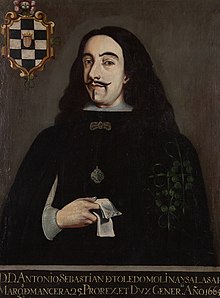Antonio Sebastián de Toledo
Antonio Sebastián de Toledo Molina y Salazar , Margrave (Spanish: marqués) of Mancera (* 1625 (according to other information: 1620 or 1608 ) in Madrid , Spain ; † 1715 in Spain) was a Spanish officer and colonial administrator who served as viceroy of New Spain officiated.
Life
Origin and youth
Antonio de Toledo was born in Spain as the only son of Pedro Álvarez de Toledo y Leiva and María Luisa de Salazar y Enríquez de Navarra. His father was the first Marqués de Mancera to be raised to hereditary nobility in 1623; Antonio inherited this title after his death. There are different statements about the year of his birth, the year 1608 being the most unlikely, as Antonio de Toledo would have reached the age of 107, which seems extremely unusual for Europeans at this time.
When his father was appointed Viceroy of Peru in 1639 , the family traveled with him to South America. Antonio de Toledo spent his youth in Peru. There he joined the Royal Spanish Navy (another argument that speaks for the year of birth 1620 or 1625, otherwise he would not have started his military career until his thirties). In the Spanish Navy he fought primarily against Dutch pirates, who at that time threatened the sea routes and ports in the Caribbean and the Pacific. Hierarchically he rose to the position of galley general.
Careers in Europe
At the end of his father's tenure, Antonio also returned to Europe in 1648. He was appointed chamberlain at the Spanish court and served the king in diplomatic missions in the Republic of Venice as well as at various stations in Germany , where he represented Spanish interests in the aftermath of the Thirty Years' War .
Afterwards he was active again in the military and commanded Spanish ships in the fight against Dutch and British privateers. Toledo was considered a close confidante of King Philip IV.
Term of office in New Spain
In 1664 the king appointed him Viceroy of New Spain despite concerns about his poor health. On October 15, 1664, Toledo made its ceremonial entry into Mexico City . At that time he did not know that his sponsor Philip IV had died on September 17, 1664. He found the state finances of the colony in bad shape, as the ongoing fighting against British privateers had burdened the budget as well as the taxes to Spain.
Toledo therefore cut spending, but at the same time ordered investments in ships for the coast guard to improve protection against pirate attacks. At this time Henry Morgan was making the Caribbean unsafe and had raided and burned several Spanish ports. Domestically, he continued efforts to drain the city and the high valley of Mexico City.
His wife, Leonor de Carreto, took the young Juana de Asbaje y Ramírez under her wing and took care of her education. Later, as Juana Inés de la Cruz, she would become the celebrated poet of Mexico.
During Toledo's tenure, the expansion of the Mexico City Cathedral was completed; the inauguration took place on June 24, 1666. New Spain suffered under his rule, as under its predecessors, from economic problems. Despite his humble administration, Toledo had to fend off two charges by the Real Audiencia that accused him of improper use of state finances.
In 1666 he asked for a replacement because of his poor health, but this was only granted to him in 1672. He handed the office over to his successor, Pedro Nuño Colón de Portugal . His wife, who was buried in Puebla , died on the way back to Europe .
Late years in Spain
In 1691 he was appointed to the Council of State ( Consejo de Estado ) in Madrid. After the death of Charles II he was initially on the side of an Austrian succession by Archduke Charles in the War of the Spanish Succession , but later switched to the side of the Bourbons, who were represented by Philip of Anjou . After Philip's victory, after falling out of favor for his pro-Bourbon attitude, he was accepted into the Spanish government cabinet in 1706.
literature
- Juana Vázquez Gómez: Dictionary of Mexican Rulers, 1325–1997 . Greenwood Publishing Group, Westport CT 1997, ISBN 0-313-30049-6 , pp. 31-32 ( Google Books ).
Web links
- Biography (PDF; Spanish)
- Biography (spanish)
- Short biography (Spanish)
- Short biography (Spanish)
| predecessor | Office | successor |
|---|---|---|
| Diego Osorio de Escobar |
Viceroy of New Spain 1664–1673 |
Pedro Nuño Colón de Portugal |
| personal data | |
|---|---|
| SURNAME | Toledo, Antonio Sebastián de |
| ALTERNATIVE NAMES | Toledo Molina y Salazar, Antonio Sebastián de (full name) |
| BRIEF DESCRIPTION | Viceroy of New Spain |
| DATE OF BIRTH | 1620 or 1625 |
| PLACE OF BIRTH | Madrid , Spain |
| DATE OF DEATH | 1715 |
| Place of death | Madrid , Spain |
